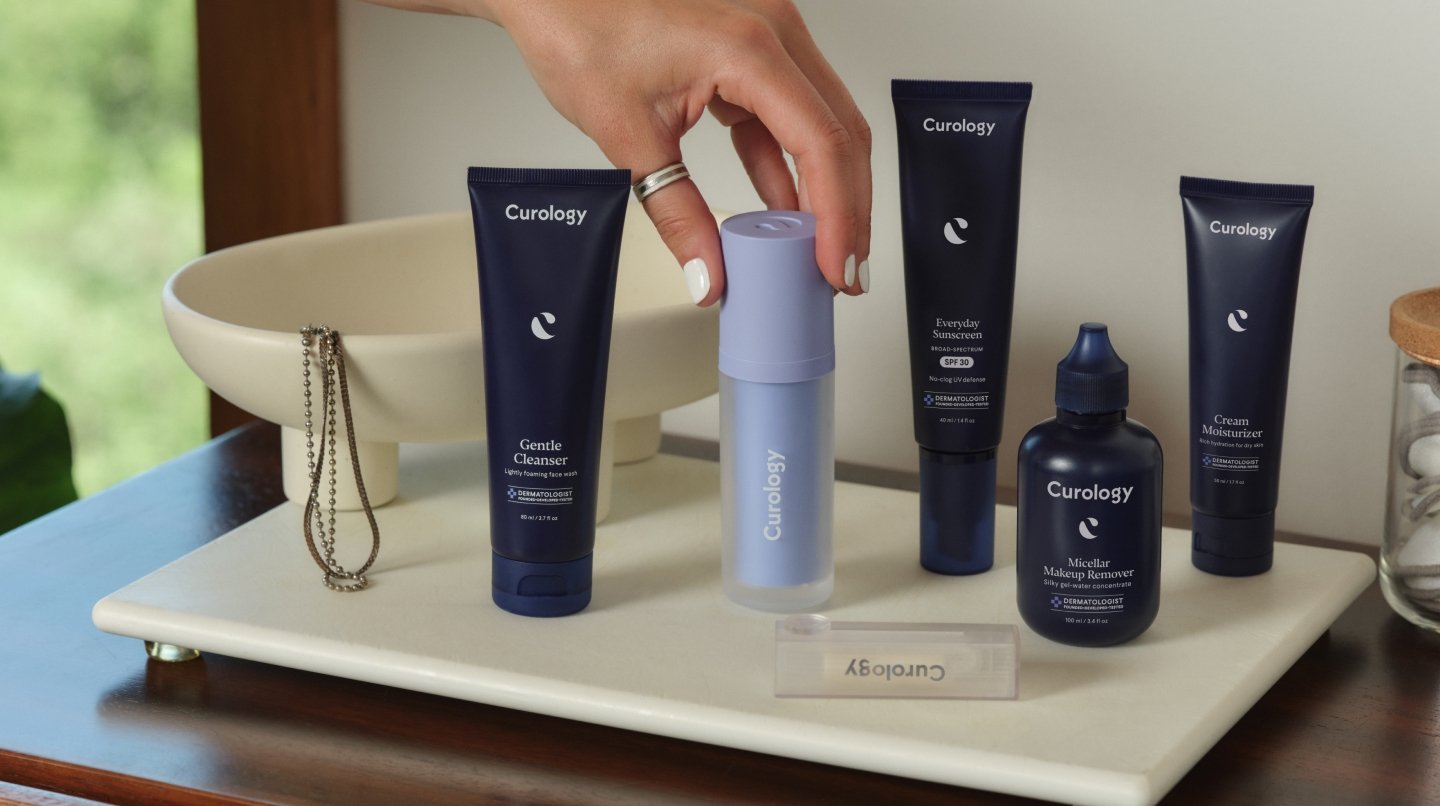How it works:
Share your skin goals and snap selfies
Your dermatology provider prescribes your formula
Apply nightly for happy, healthy skin
How it works:
How it works:
Share your skin goals and snap selfies
Your dermatology provider prescribes your formula
Apply nightly for happy, healthy skin
How it works:
The truth about actives in skincare
What’s the deal with these buzzy ingredients? Allow us to explain.



Finding effective products to incorporate into your skincare routine for clear, radiant, and healthy skin can be a struggle.
Taking the time to look over the list of active ingredients, or actives, can make all the difference when it comes to choosing the right product for your skin. Active ingredients all provide specific benefits, from fighting acne to having an anti-aging effect.
Whether you're dealing with dark spots, wrinkles, or other skin concerns, the right active ingredients can get you closer to your skin goals. Here, we'll explore the benefits of actives and the best practices for incorporating them into your skincare routine.
What are active ingredients in skincare?
When it comes to skincare, active ingredients play a vital role in a product’s efficacy. Active ingredients are substances that have the ability to change the structure or function of the skin,¹ delivering various benefits such as anti-aging, antioxidant, photo-protective, anti-inflammatory and antimicrobial effects.²
Active ingredients are known to be strong, science-backed compounds that can enhance the skin's appearance and overall health. For example, Vitamin C and Vitamin E are powerful antioxidants that can help protect the skin from damaging free radicals and work in combination for photoprotection.³ AHAs (Alpha Hydroxy Acids) and BHAs (Beta Hydroxy Acids) are exfoliants that work by removing dead skin cells which may improve skin dullness.⁴ And hyaluronic acid is known to hydrate the skin to help minimize the signs of aging as well, in addition to being an important delivery system for other active ingredients.⁵
Active ingredients work by penetrating the skin's surface and targeting specific concerns, such as acne, hyperpigmentation, or signs of aging. Depending on the specific ingredient, they may enhance collagen production and improve the skin's elasticity, resulting in a more radiant complexion.⁶
Common active ingredients in skincare products
Many skincare cosmetics on the market today contain active ingredients. Below is a list of some common ones.
Alpha hydroxy acid
AHAs are a type of organic acid that can be found in many foods and milk sugars. Glycolic acid, lactic acid, malic acid, tartaric acid, and citric acid are all examples of AHAs, and they're often used in cosmetics to help improve the appearance of skin.
They can be used to peel away dead skin cells, which may help treat concerns such as acne, melasma, roughness, and wrinkles.⁷ AHAs are commonly used in a variety of cosmetic products, including anti-aging formulas, moisturizers, peels, and treatments for hyperpigmentation. One of the ways AHAs can benefit the skin is by stimulating cell renewal. This can lead to improvements in firmness, elasticity, and a reduction in lines and wrinkles. Scientists have been studying how AHAs can help "de-age" the skin, and some believe that it’s may be due to their ability to increase cell renewal.⁸
The non-clinical data made public by the FDA suggests that using AHAs at low concentrations topically is safe. However, it's important to exercise caution when using AHA products as they may cause adverse reactions such as redness, swelling, burning, or itching. It's worth noting that the safety and effectiveness of AHA products depend on various factors such as the concentration, pH, exposure time, and the amount of free acid present.⁹
Benzoyl peroxide
Benzoyl peroxide is one of the most widely used topical agents for the treatment of acne. It is available in a range of formulations, including gels, ointments, and washes, and can be found in non-prescription monotherapeutic forms, as well as in prescription-only combinations with retinoids or antibiotics. Combining benzoyl peroxide with antibiotics is a vital aspect of topical acne treatment, as it can help to prevent bacterial resistance to antibiotics.
While benzoyl peroxide is generally well-tolerated, some individuals may experience side effects such as itching, redness, and dryness especially when used in higher concentrations. However, with proper use and guidance from a healthcare professional, benzoyl peroxide may be an effective option for acne treatment.¹⁰ It's important to note that benzoyl peroxide is both an over-the-counter topical medication and an FDA-approved prescription medication. Its accessibility makes it a popular choice for many individuals seeking acne treatment, but it's always best to consult with a healthcare provider to determine the best course of treatment.¹¹
Beta hydroxy acids
Beta Hydroxy Acids (BHAs), such as salicylic acid, are similar to AHAs in many ways, except for their solubility. BHAs are lipid-soluble, while AHAs are water-soluble. Because of this, BHAs are able to penetrate the skin through sebaceous follicles, which makes them particularly effective for people with oily skin. Moreover, BHAs have been shown to have a proven anti-inflammatory effect, and they are generally less irritating to the skin than AHAs. It is recommended to use skin-care products containing BHAs in a concentration of 1-2% for optimal results.¹²
Users should follow the use instructions on the label. Avoid using BHA-containing products on infants and children, and use sun protection when using BHA products.¹³
Ceramides
Ceramides are a type of fatty substance that is naturally found in the uppermost layer of our skin. This layer is responsible for protecting our body from external factors such as the sun, wind, and pollution.
Ceramides help to maintain the structure and function of this protective layer by forming a part of the lipid membranes that surround the skin cells. When there is a change in the number of ceramides present in the skin, it can lead to various skin problems. Recently, skin care products have started including ceramides to help restore and maintain healthy skin by improving the skin's protective barrier.¹⁴ Based on data from the FDA, the Expert Panel for Cosmetic Ingredient Safety concluded that ceramides are safe in cosmetics in the present practices of use and concentration.¹⁵
Hydroquinone
Hydroquinone has been a popular choice of active for people looking to treat skin hyperpigmentation. It is a powerful topical ingredient that works by preventing the production of melanin, the substance responsible for skin darkening.
However, it's worth noting that although hydroquinone is effective, it can come with some side effects, such as redness, itching, stinging, allergic reactions, and rarely, a blue-black discoloration called onchronosis.¹⁶ Because of this, it's important to exercise caution when using hydroquinone and to always consult with a healthcare provider before starting treatment. It's worth noting that skin-lightening products containing hydroquinone are not approved for over-the-counter sale by the FDA, and therefore require a prescription from a medical professional.¹⁷

Choose the right actives for your skin
Active ingredients play a vital role in the effectiveness of skincare products. They are substances that can change the structure or function of the skin and provide specific benefits such as anti-aging, antioxidant, photo-protective, anti-inflammatory, and antimicrobial effects.
Get your personalized skincare routine with Curology
Get your personalized skincare routine with Curology


Understanding active ingredients and their benefits can help you choose the right products for your specific skincare needs. That’s where Curology can help. Our licensed dermatology providers are available to share guidance on which actives might be best for your skin. They can also help you create a skincare routine designed for your unique concerns and goals. Getting started is easy—sign up to start a 30-day trial* now.
FAQs
Commonly used actives include retinol, Alpha Hydroxy Acids (AHA), Beta Hydroxy Acids (BHA), niacinamide, and vitamin C. Each of these active ingredients addresses certain skin concerns.¹⁸
A purely cosmetic product is defined by its intended use (such as a cleanser for cleansing), whereas an “active” ingredient is capable of altering the structure or function of the skin. In simple terms, an active ingredient has a greater potential to produce skin benefits.¹⁹
Niacinamide is a form of Vitamin B3 and may be an active ingredient in certain products. It’s widely used for its ability to decrease inflammation and reduce pigmentation.²⁰
P.S. We did the homework so you don't have to:
Rodan, K. et al. The Evolving Role of Skincare. PRS Global Open. (2016, December 14).
Kouassi, M-C., et al. Multifunctional active ingredient-based delivery systems for skincare. Colloids and Surfaces B: Bioinferences. (2022, June 30).
Choi, C.M. and Berson, D.S. Cosmeceuticals. WBS. (2006, n.d.).
Choi, C.M. and Berson, D.S. Cosmeceuticals. WBS. Ibid.
Juncan, A.M., et al. Advantages of Hyaluronic Acid and Its Combination with Other Bioactive Ingredients in Cosmeceuticals. Molecules. (August 2021).
Rodan, K., et al. Skincare Bootcamp: The Evolving Role of Skincare. PRS Global Open. Ibid.
Tang, S-C. and Yang, J-H. Dual Effects of Alpha-Hydroxy Acids on the Skin. Molecules. (2018, April 10).
Tang, S-C. and Yang, J-H. Dual Effects of Alpha-Hydroxy Acids on the Skin. Molecules. Ibid.
Tang, S-C. and Yang, J-H. Dual Effects of Alpha-Hydroxy Acids on the Skin. Molecules. Ibid.
Brammann, C. and Müller-Goymann, C.C. An update on formulation strategies of benzoyl peroxide in efficient acne therapy with special focus on minimizing undesired effects. International Journal of Pharmaceutics. (2020, March 30).
Martin, T. and Goodman, M.B. Benzoyl Peroxide. StatPearls. (2022, October 10).
Moghimipour, E. Hydroxy Acids. Jundishapur Journal of Natural Pharmaceutical Products. (2012, January 4).
U.S. Food & Drug Administration. Beta Hydroxy Acids. (2022, February 25).
Kahraman, E., et al. Recent Advances on Topical Applications of Ceramides to Restore Barrier Function of Skin. Cosmetics. (2019, August 20).
Burnett, C.L., et al. Safety Assessment of Ceramides as Used in Cosmetics. International Journal of Toxicology. (2020, November 18).
Schwartz, C., et al. Hydroquinone. StatPearls. (2023, March 7).
U.S. Food & Drug Administration. Skin Product Safety. (2022, October 27).
Glass, G.E. Cosmeceuticals: The Principles and Practice of Skin Rejuvenation by Nonprescription Topical Therapy. Aesthetic Surgery Journal Open Forum. (2020, August 11).
Rodan, K., et al. Skincare Bootcamp: The Evolving Role of Skincare. PRC Global Open. Ibid.
Borrego-Sánchez, A. et al. Theoretical Study of Retinol, Niacinamide and Glycolic Acid with Halloysite Clay Mineral as Active Ingredients for Topical Skin Care Formulations. Molecules. (2021, July 21).
Elise Griffin is a certified physician assistant at Curology. She received her Master of Medical Science in physician assistant studies from Nova Southeastern University in Jacksonville, FL.
*Cancel at any time. Subject to consultation. Results may vary.

Curology Team

Elise Griffin, PA-C
Related Articles
Wrinkles and other signs you’re doing it rightWhat should your underarm care routine look like?The science behind our skincare quiz: why it worksSkincare tips for dry skin, according to dermatology providersSkincare over 40s: skin tips from dermatology expertsPopular Articles
Ask Curology: Is my cold breaking me out?Slugging: The dermatologist-approved skincare hack going viral on TikTokTretinoin vs retinol: What’s the difference?How to create a self-care routine that actually sticksYour 2023 skincare horoscopeTry prescription skincare
Get routine essentials

Good skin days ahead
- Breakouts
- Redness
- Fine lines
- Dark spots
- Hair thinning